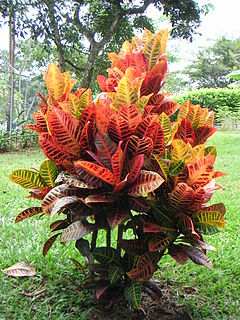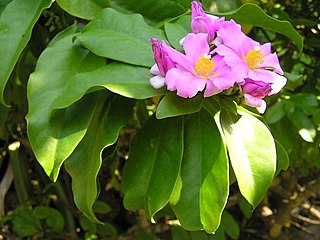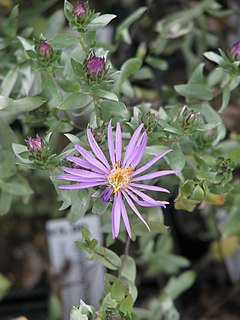
Melastomataceae is a family of dicotyledonous flowering plants found mostly in the tropics comprising c. 175 genera and c. 5115 known species. Melastomes are annual or perennial herbs, shrubs, or small trees.

Tibouchina is a neotropical flowering plant genus in the family Melastomataceae. Species of this genus are subshrubs, shrubs or small trees and typically have purple flowers. They are native to Mexico, the Caribbean, and South America where they are found as far south as northern Argentina. Members of this genus are known as glory bushes, glory trees or princess flowers. The name Tibouchina is adapted from a Guianan indigenous name for a member of this genus. A systematic study in 2013 showed that as then circumscribed the genus was paraphyletic, and in 2019 the genus was split into a more narrowly circumscribed Tibouchina, two re-established genera Pleroma and Chaetogastra, and a new genus, Andesanthus.

Pleroma semidecandrum, synonym Tibouchina semidecandra, the princess flower, glory bush, or lasiandra, is a flowering plant in the family Melastomataceae, native to southeast Brazil.

Lavandula angustifolia, formerly L. officinalis, is a flowering plant in the family Lamiaceae, native to the Mediterranean. Its common names include lavender, true lavender or English lavender ; also garden lavender, common lavender, and narrow-leaved lavender.

Physocarpus, commonly called ninebark, is a genus of flowering plants in the family Rosaceae, native to North America and northeastern Asia.

Codiaeum variegatum is a species of plant in the genus Codiaeum, which is a member of the family Euphorbiaceae. It was described by Carl Linnaeus in 1753. It is native to Indonesia, Malaysia, Australia, and the western Pacific Ocean islands, growing in open forests and scrub.

Pleroma elegans, synonym Tibouchina elegans, is an ornamental plant in the family Melastomataceae.

Rhodocactus grandifolius is a species of cactus native to eastern and southern Brazil. Like all species in the genus Rhodocactus and unlike most cacti, it has persistent leaves. It was first described in 1819. It is grown as an ornamental plant and has naturalized outside its native range.

Lamium maculatum is a species of flowering plant in the family Lamiaceae, native throughout Europe and temperate Asia.

Thalictrum dioicum, the early meadow-rue or quicksilver-weed, is a species of herbaceous plants in the family Ranunculaceae. Plants are typically upright growing woodland natives from Colorado Rocky Mountain forests to central and eastern North America including parts of south eastern Canada. This species has dioecious plants, with male and female flowers on separate plants blooming in early to mid spring.

Sambucus racemosa is a species of elderberry known by the common names red elderberry and red-berried elder.

Symphyotrichum sericeum is a species of flowering plant in the family Asteraceae native to central North America. Commonly known as western silver aster, western silvery aster, and silky aster, it is a perennial, herbaceous plant that may reach 70 centimeters tall. Its flowers have purple ray florets and pink then purple disk florets, and its leaves are firm and silvery-green.

Salvia longispicata is a perennial shrub native to southwestern Mexico, growing between 1,000 and 6,500 feet elevation. The specific epithet "longispicata" gives the impression that the plant has "long spikes", but instead refers to the many projecting clusters of short flowering spikes that resemble small ears of corn.

Hydrangea heteromalla is a species of flowering plant in the family Hydrangeaceae. It is commonly known as woolly hydrangea, Himalayan hydrangea or Chinese hydrangea and is native to the Himalayas and China. Average height is 10'-15' with inflorescences that are 5"-8" across and bloom May–June, full flowering only occurs in full sun. Leaves are elliptical or ovate and margins are slightly serrated. Is a very adaptable plant that is hardy to USDA zones (4)5-7. This plant is seldom seen in American gardens. There is a nice specimen at the Sir Harold Hillier Gardens. Hydrangea heteromalla is a deciduous shrub or small tree. Its native habitats include alpine forests and thickets in the Himalayas and China.

Bertolonia is a genus consisting of 14 species of pretty, dwarf, creeping, tender perennials, native to tropical South America. These herbaceous plants are grown for their colorful, velvety, ornamental foliages, vary from shimmery white with purple, pink with purple, or bronze-green with carmine and lighter midribs, purple beneath. Leaves are coarsely hairy, oval 7 cm (3 in) long on short stalks. The plants bear clusters of small, bell-shaped flowers repeatedly, just above the leaves, color ranges from pink, red, yellow to purple.

Pleroma raddianum, synonyms including Pleroma pulchrum(Cham.) Triana and Tibouchina pulchra, is a plant species in the family Melastomataceae.

Pleroma urvilleanum, synonym Tibouchina urvilleana, is a species of flowering plant in the family Melastomataceae, native to Brazil.

Chaetogastra grossa, synonym Tibouchina grossa, is a species in the Melastomataceae family that is native to Colombia, Ecuador and Venezuela. It is found between 2400 and 3800 meters in elevation. Also called "red princess flower" or "carmine princess flower" to differentiate it from "princess flower" which has purple blooms.

Pleroma granulosum, synonym Tibouchina granulosa, is a species of tree in the family Melastomataceae. It is also known as purple glory tree or princess flower. It is native to Bolivia and Brazil. Because its purple-flowers bloom for most of the year, this tree is often used for gardening in Brazil, where is known by the name quaresmeira.

Tibouchina lepidota, also known as alstonville, Andean princess flower, lasiandra, or glory bush, is a medium-sized ornamental tree or a large shrub native to northwestern South America that is cultivated for its masses of purple flowers from autumn right through to winter.
























